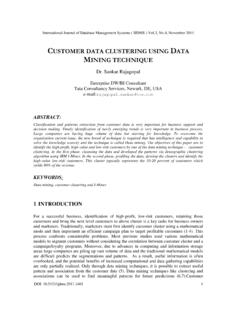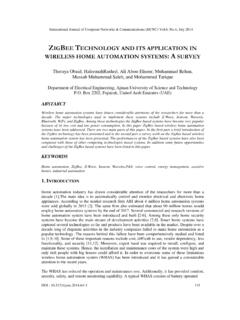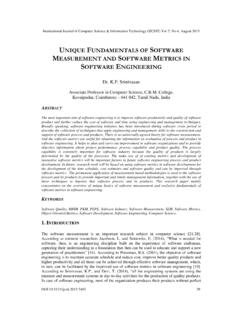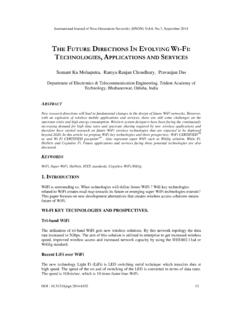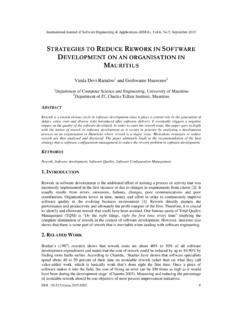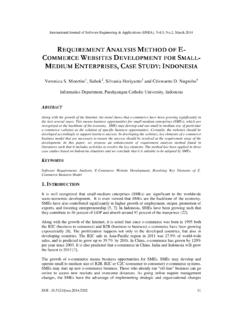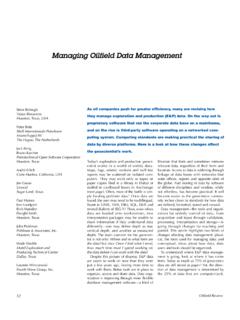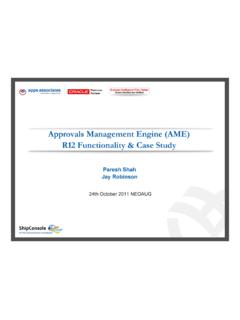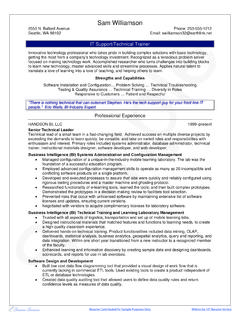Transcription of A Study on Challenges and Opportunities in …
1 International Journal of Database management Systems ( IJDMS ), , , May 2011 DOI: 129 A Study on Challenges and Opportunities in master data management . Tapan kumar Das1 and Manas Ranjan Mishra2 1 SITE, VIT University, Vellore, TN, India 2 IBM India Pvt .Ltd, Bangalore, India Abstract This paper aims to provide a data definition of one master data for cross application consistency. The concepts related to master data management in broader spectrum has been discussed. The current Challenges companies are facing while implementing the MDM solutions are outlined. We have taken a case Study to highlight why master data management is imperative for the enterprises in optimizing their business Also we have identified some of the long term benefits for the enterprises on implementing Keywords data quality, Information system, Unstructured, Transactional data 1.
2 Introduction The increasing amount of data is creating Challenges to companies data management practices, causing data quality problems which are very common in companies now-a days[3,9,10]. The life cycle of a typical product involves different phases like design, material acquisition, manufacture, distribution, sale, use, service and termination. Each stage requires different data which need to be managed in an integrated and systematic manner to provide accurate information at the right time to various stakeholders [15,22].Workgroups, such as organization departments, develop data processes in silos which lead to variance in the business concepts and object definitions [14]. The need to share information across the organizations and supply chains is driving data from silos to be exposed, unified and shared.
3 This reveals enormous data discrepancies and incompatibilities [2,7].It is important to note that although data warehousing and business intelligence are an absolutely essential part of modern information technology and have brought great value to business decision-making and operational efficiencies, these solutions often did not create the desired single view of the business [6]. The companies have been facing the Challenges of getting the single view of business data from hundreds of data entry terminals. master data management are the key. It fixes the data quality problem on the operational side of the business .It augments and operate the data warehouse on the analytical side of the business [6]. Twenty five years after data ware housing s inception, a recent survey found that a common top ten CIO request is to get a single view of the customer.
4 One analyst reports 75% of leading companies are incapable of creating a unified view of their International Journal of Database management Systems ( IJDMS ), , , May 2011 130 customer[4].This is because, as we saw in earlier sections, the master data consists of facts that define a business entity, facts that may be used to model one or more definitions or views of an entity. Entity definitions based on master data provide business consistency and data integrity when multiple IT systems across an organization (or beyond) identify the same entity differently. Business analytics get more relevant and competitive information from big data warehouses, but the data sources still remain inconsistent. These data quality issues affect operational efficiency and also produce inaccurate reports. The purpose of this paper is to get an insight about practical difficulties in MDM space.
5 In addition to that, this Study is an attempt for understanding the concept of MDM and its meaning in business context as a whole. Also we have identified the Opportunities in this landscape. The Study addresses the issue in consensus driven approach. We first reviewed the literature, then case Study analysis and finally by experts interviews. 2. Literature review on MDM and related concepts master data master data is the critical business information related to the transactional and analytical operations of the enterprise. master data management (MDM) is a combination of applications and technologies that consolidates, cleans, augments corporate data and synchronizes it with all applications, business processes, and analytical tools. This results in significant improvements in operational efficiency, accurate reporting and strategic decision making[6].
6 master data describes the business-oriented properties of data objects which are used in the different applications across the organization together with their associated metadata, attributes, definitions, roles, connections and taxonomies [5,11]. master data is the data that has been cleansed, standardized and integrated into an enterprise-wide system [1] and used across multiple business domain. Core entities are parties (organization, customer, prospect, people, citizens, employees, vendors, suppliers or trading partners), places (locations, offices, regional alignments or geographies) and things (accounts, assets, policies, product or services) [14,20]. There are essentially five types of data in corporations [21]: Unstructured This data is found in e-mail, white paper , magazine articles, corporate intranet portals, product specifications, marketing collateral, and PDF files.
7 Transactional This data is related to sales, orders, invoices, entries, claims. Metadata This is data about data in data warehouse. It may reside in repository or in various other forms such as XML documents, report definitions, column descriptions in a log file. Hierarchical Hierarchical data s tores the relationships between other data . It may be stored separately as descriptions of real-world relationships such as company organizational structures or product lines. International Journal of Database management Systems ( IJDMS ), , , May 2011 131 master master data is the key to business and fall generally into four categories: people, things, places, and concepts. Further they are grouped along subject areas, domain areas, or entity types. For example, within people, there are customer, employee, and third party personnel.
8 Within things, there are product, store, commodity and asset. Within concepts, there are things like agreement, warrantee, and licenses. Finally within places, there are office locations, sites and geographic divisions. Some of these domain areas may be further divided. Customer may be further segmented based on priority, credits. Product may be further segmented by category, sector and industry. master data management master data management (MDM) is the technology, tools, and processes required to create and maintain clean, consistent and accurate lists of master data . MDM tackles master data management in the operational area, managing it in the most appropriate place. MDM is complementary to business intelligence and provide an excellent source of dimensional data [16].
9 MDM is the latest attempt to solve the old problem of inconsistent versions of critical data at the centre of an organization, said Andrew White, research vice president at Gartner summit 2011[8]. Product data management (PDM) systems are used to manage all product-related data and also product master data . Customer data integration (CDI) systems are used to manage customer master data . The customer in CDI is used as a generic term, which can mean also a client, contact, party, counterparty, patient, subscriber, supplier, prospect, service provider, citizen, guest, legal entity, trust, business entity and other [1] Emphasis on data quality, integration, single version of the truth, data stewardship [12] MDM is not just a technological problem. In many cases, fundamental changes to business process will be required to maintain clean master data , and some of the most difficult MDM issues are more political than includes both creating and maintaining master data .
10 Investing a lot of time, money, and effort in creating a clean, consistent set of master data is a wasted effort unless the solution includes tools and processes to keep the master data clean and consistent as it is updated and expanded [13]. master data management has two architectural components [4]: 1. The technology to profile, consolidate and synchronize the master data across the enterprise 2. The applications to manage, cleanse, and enrich the structured and unstructured master data International Journal of Database management Systems ( IJDMS ), , , May 2011 132 MDM Phases An MDM project plan is associated with requirements, priorities, resource availability, time frame, and the size of the problem. According to Roger Wolter ,Microsoft Inc[21], most MDM projects include at least these phases: 1.
